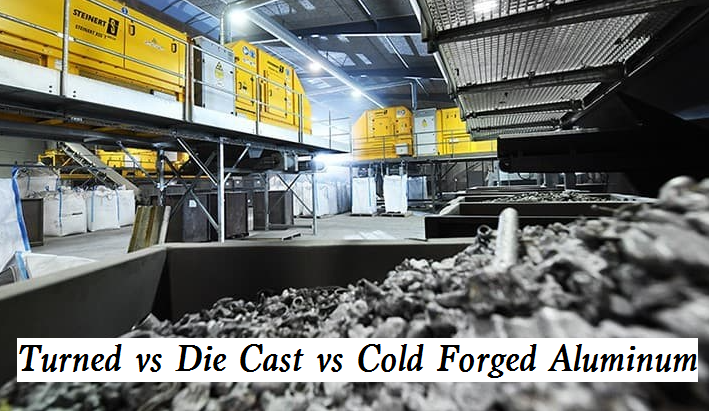Die casting, CNC turning, and cold forging are different manufacturing processes of aluminum, what is the difference between them? We’ll look into an example of aluminum LED energy-saving lamp shells.

Aluminum Die Casting vs Aluminum Turning
1. Materials
Die casting aluminum alloy generally adopts ADC12 or ALsi9cu3. Aluminum CNC turning generally adopts 6063 or 6061.
2. Appearance.
Die-cast aluminum is similar to the plastic injection molding process, which can produce any shape. Generally, the housing on street lamps is made of die-cast aluminum. The constant cross-section shape adopted by the turned aluminum has little change, such as the radiator of bulb lamp and aluminum profiles of doors and windows.
3. Thermal conductivity
The general conductivity of die-cast aluminum is about 80 – 90W/M K. The thermal conductivity of aluminum is about 180 – 190W/M K.
4. Cost
The cost of die castings and aluminum lathes is relatively calculated by weight and machining. Calculate the cost according to the real-time material price and labor. Relatively speaking, the cost of die-casting aluminum is higher, but the specific situation needs specific analysis.
5. Production efficiency
The production efficiency of casting is higher. Generally, more than 1000 pieces are produced in a day in batch production, and the size is stable. The shrinkage rate is 0.5%. Machined aluminum has more components. As the name suggests, aluminum is aluminum. The efficiency is naturally lower.
6. Application
Die cast aluminum is widely used in automobiles, street lamps, and now the mobile phone industry, and turned aluminum is widely used in downlights, ceiling lamps, doors, windows, etc.
For aluminum LED energy-saving lamp shells, what’s the difference between turned aluminum and die cast aluminum?
LED energy-saving lamps will gradually replace incandescent lamps, even the current ordinary energy-saving lamps. In order to solve the heat dissipation problem of LED energy-saving lamps, aluminum shells are basically selected. At present, various types of aluminum shells of LED energy-saving lamps are emerging in the market, but they are basically produced through die casting and turning.
The aluminum shell of die-casting LED energy-saving lamps is generally made of zinc-aluminum alloy, and many small power spotlights basically use this process. Its advantages are low production cost, and fast production speed, but poor heat dissipation. The LED energy-saving lamps with higher power are all processed by a CNC lathe, and the turning can also be fine and thin so that the heat dissipation surface area will increase and the heat dissipation effect will be enhanced. Its advantages are that the heat dissipation effect is obviously better than that of die casting, but the production speed is slow and the cost is far higher than that of die casting.
Turned Aluminum vs Die Cast Aluminum vs Cold Forged Aluminum
– Price. For aluminum turning, the aluminum profile drawing die needs to be opened. The die-casting radiator needs to open the casting mold. Cold forging radiator needs to open the forging die. If the price of dies for products with the same shape is divided into high, medium, and low, the price of die casting dies is high, the price of forging dies is moderate, and the price of profile drawing dies is low. If the processing cost of products with the same shape is divided into high, medium, and low, the machining price of profiles is high, the die-casting price is moderate, and the forging price is relatively cheap.
– Materials & Production Cycle. The die casting material is ADC12, which is relatively cheap. The machining and forging materials are mostly A6063, which is relatively expensive. Aluminum profile machining (turning aluminum) is used to make LED radiators, and A6063 material is mostly used. Advantages: the heat dissipation effect of the product is relatively good, and the surface treatment of the finished product is relatively easy. The mold production cycle is short, usually taking 10-15 days, and the mold price is cheap. Disadvantages: higher machining cost and lower output. The LED radiator is made of die-casting, and most of the materials are ADC12. The advantages are low processing costs and high production capacity. If the mold allows, it can produce radiators of various shapes. The disadvantage is that the mold cost is high, and the mold production cycle is long, which usually takes 30-45 days. The LED radiator made of cold forging can be made of any material theoretically. The advantages are low processing costs and high production capacity. The mold production cycle is short, usually taking 10-15 days, and the mold price is cheap. The disadvantage is that due to the limitation of the forging process, it is impossible to produce products with complex appearances.
Which one to choose? Turning or machining is recommended for small-batch products, die casting is ideal for high-volume complex parts, then cold forging is suitable for large-batch simple components.

